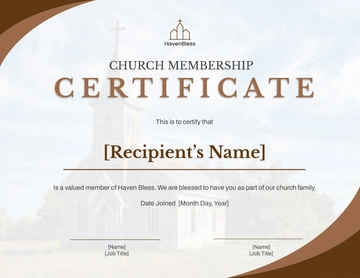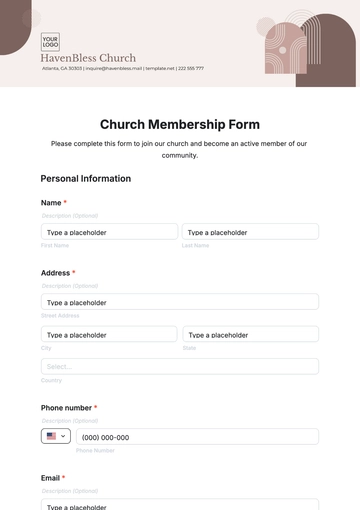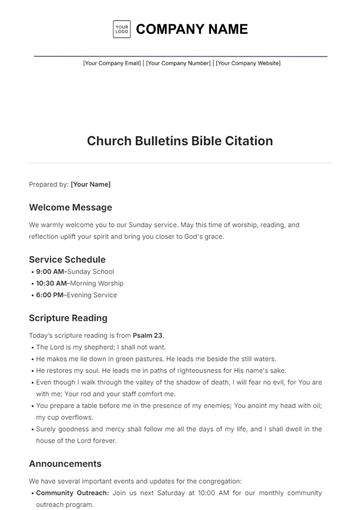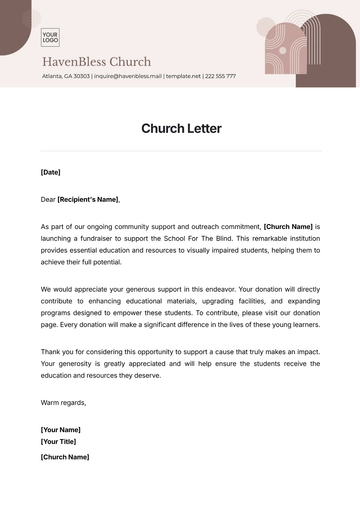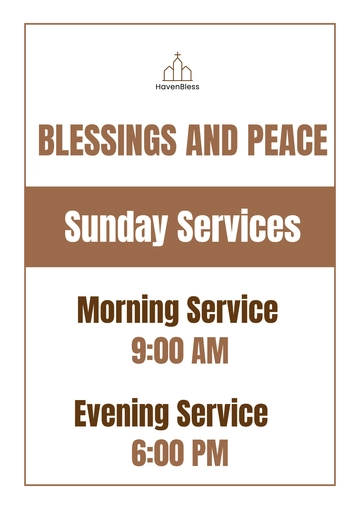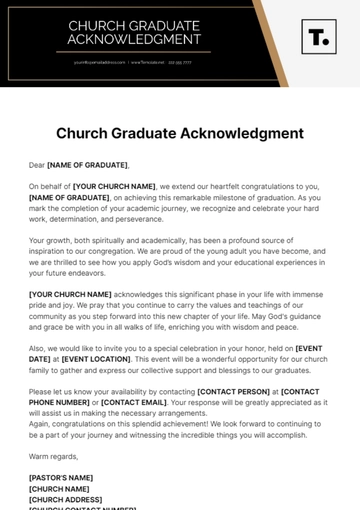Free Professional Church Crisis Management Policy
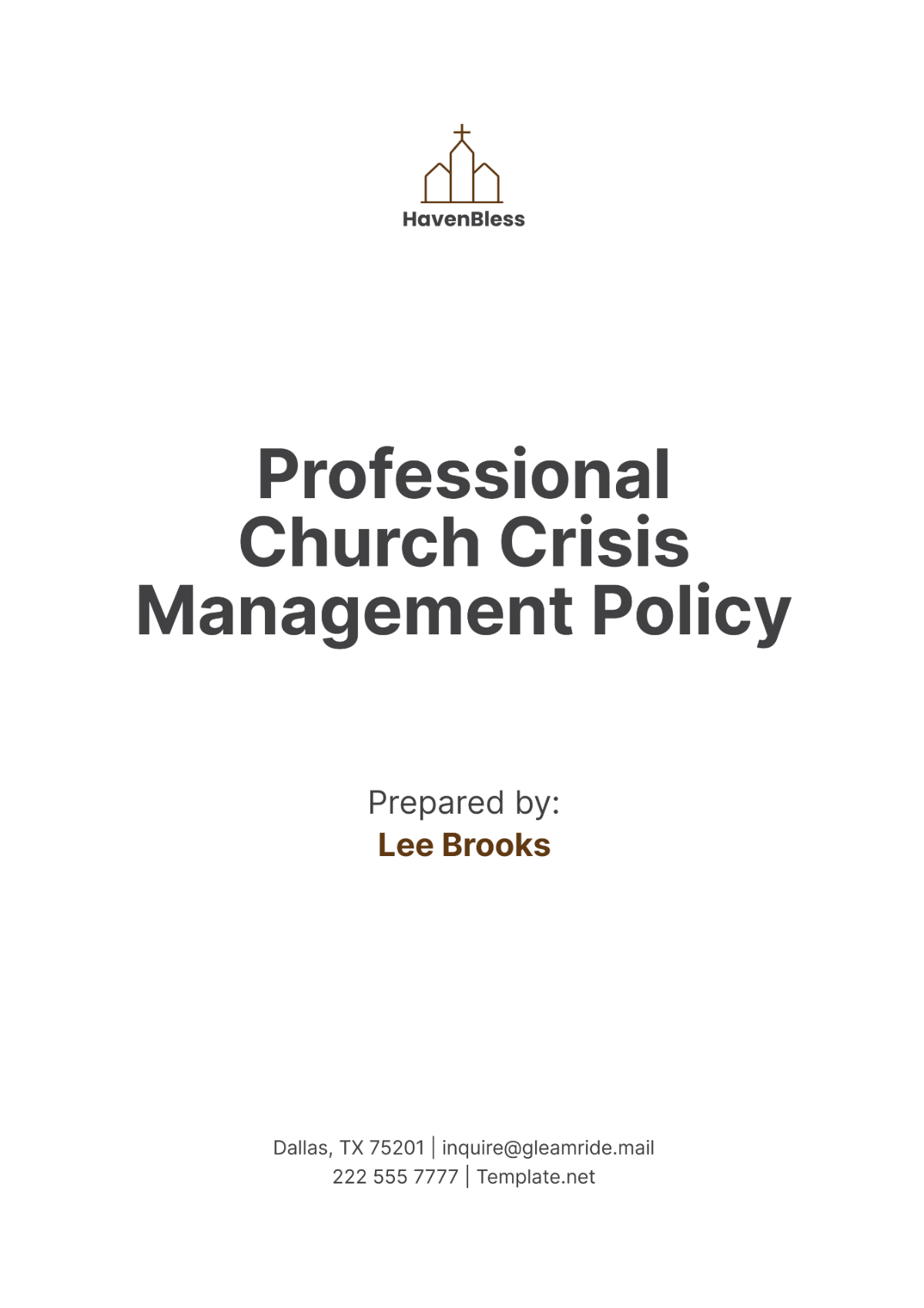
I. Introduction
Effective crisis management is essential for maintaining the stability and integrity of [Your Company Name]. This Church Crisis Management Policy outlines the procedures and responsibilities for handling various crises that may arise at [Your Company Name]. The aim is to ensure that all church staff and members are prepared to respond appropriately in any emergency situation.
A. Purpose
Ensure Readiness: This policy aims to ensure that the church is prepared to handle crises efficiently and effectively, reducing the likelihood of escalation and ensuring swift recovery.
Protect Members: The primary focus is to protect the well-being and safety of all church members and visitors through clear guidelines and swift actions.
Maintain Operations: Ensuring that church operations can continue or resume quickly after a crisis is a key objective, minimizing disruption to worship and community services.
Promote Communication: Effective communication during crises is essential to keep everyone informed and safe, utilizing multiple channels to ensure message delivery.
B. Scope
Applicability: This policy applies to all church staff, volunteers, and members, ensuring a unified and comprehensive response to crises.
Types of Crises: It covers natural disasters, medical emergencies, security threats, and other significant disruptions, providing guidelines for diverse scenarios.
Responsibilities: Outlines the roles and responsibilities of church leaders and members in crisis situations, ensuring accountability and clarity.
Resources: Identifies the resources and support systems available to manage crises, ensuring preparedness and effective response.
Procedures: Details the procedures to follow before, during, and after a crisis, ensuring systematic and consistent actions.
II. Crisis Management Team
The Crisis Management Team (CMT) is responsible for implementing this policy and ensuring a coordinated response to emergencies. The following table outlines the key members of the CMT and their roles:
No. | Role | Description |
|---|---|---|
1 | Crisis Manager | Leads the CMT and oversees all crisis management activities. |
2 | Communication Lead | Manages internal and external communications during crises. |
3 | Safety Officer | Ensures the safety and security of all individuals. |
4 | Medical Officer | Provides medical assistance and coordinates with health services. |
5 | Logistics Officer | Manages resources and logistics during crises. |
A. Crisis Manager
Leadership Role: The Crisis Manager leads the CMT and coordinates all crisis management activities. They ensure the team functions smoothly and all tasks are completed efficiently.
Decision-Making: Responsible for making critical decisions during crises, ensuring swift and effective responses to minimize impact.
Liaison: Acts as the primary liaison between the church and external agencies, facilitating coordination and support from local authorities and organizations.
Evaluation: Evaluates the effectiveness of crisis response and implements improvements, ensuring continuous enhancement of crisis management strategies.
Documentation: Ensures all crisis management activities are documented for review, providing a record for future reference and learning.
B. Communication Lead
Information Dissemination: Manages the dissemination of information to staff, members, and the public, ensuring accurate and timely updates.
Media Relations: Handles media inquiries and releases official statements, maintaining the church’s reputation and providing necessary information.
Internal Updates: Provides regular updates to church leadership and members during crises, ensuring transparency and keeping everyone informed.
Communication Channels: Ensures effective use of various communication channels (e.g., social media, email, text messages, and church bulletins), ensuring message delivery to all relevant parties.
Feedback Collection: Collects feedback on communication effectiveness and adjusts strategies as needed, ensuring continuous improvement.
C. Safety Officer
Safety Protocols: Develops and enforces safety protocols to protect individuals during crises, ensuring adherence to best practices.
Security Measures: Implements security measures to prevent and respond to threats, ensuring a safe environment for all.
Evacuation Plans: Ensures evacuation plans are in place and communicated to all members, facilitating orderly and safe evacuations.
Training: Conducts safety training sessions for staff and members, ensuring everyone is prepared to respond to emergencies.
Safety Audits: Performs regular safety audits to identify and address potential risks, ensuring continuous safety improvements.
D. Medical Officer
First Aid: Provides first aid and medical assistance to those in need, ensuring prompt medical care.
Health Services Coordination: Coordinates with local health services for additional support, ensuring comprehensive medical response.
Medical Supplies: Ensures medical supplies are available and accessible, maintaining an inventory of necessary items.
Health Records: Maintains health records and reports on medical incidents, ensuring accurate documentation and follow-up.
Wellness Programs: Develops wellness programs to promote health and safety, ensuring ongoing support for the church community.
E. Logistics Officer
Resource Management: Manages resources and logistics to support crisis response, ensuring availability and effective use of resources.
Supply Chain: Ensures the availability and distribution of necessary supplies, coordinating with suppliers and partners.
Facility Management: Oversees the management of church facilities during crises, ensuring their readiness and functionality.
Transportation: Coordinates transportation for evacuation and other needs, ensuring safe and efficient movement of individuals.
Inventory Control: Maintains an inventory of emergency supplies and equipment, ensuring their readiness and accessibility.
III. Crisis Prevention and Preparedness
Effective prevention and preparedness measures can significantly reduce the impact of crises. The following table outlines the key prevention and preparedness activities:
No. | Activity | Description |
|---|---|---|
1 | Risk Assessment | Identifying potential risks and vulnerabilities. |
2 | Emergency Planning | Developing comprehensive emergency plans and procedures. |
3 | Training and Drills | Conducting regular training and drills for staff and members. |
4 | Communication Systems | Establishing reliable communication systems for emergencies. |
5 | Resource Allocation | Allocating resources and supplies for emergency preparedness. |
6 | Community Engagement | Engaging with the community to promote awareness and preparedness. |
A. Risk Assessment
Identify Risks: Conduct regular risk assessments to identify potential threats, ensuring proactive measures can be taken to mitigate them.
Vulnerabilities: Assess vulnerabilities within the church and its operations, ensuring all potential weak points are addressed.
Mitigation Strategies: Develop strategies to mitigate identified risks, ensuring comprehensive protection against various threats.
Review: Review and update risk assessments periodically, ensuring they remain relevant and effective.
Documentation: Document all findings and mitigation strategies, ensuring a clear record for reference and action.
B. Emergency Planning
Plan Development: Develop comprehensive emergency plans for various scenarios, ensuring preparedness for different types of crises.
Role Assignment: Assign roles and responsibilities to staff and members, ensuring everyone knows their duties during emergencies.
Resource Allocation: Allocate necessary resources and supplies for emergencies, ensuring readiness and swift response.
Communication Plans: Establish clear communication plans for crisis situations, ensuring information flows smoothly.
Plan Review: Regularly review and update emergency plans, ensuring they remain effective and relevant.
C. Training and Drills
Regular Training: Conduct regular training sessions for staff and members, ensuring everyone is well-prepared.
Drills: Organize drills to practice emergency procedures, ensuring everyone knows what to do in real scenarios.
Feedback: Collect feedback from participants to improve training and drills, ensuring continuous enhancement.
Evaluation: Evaluate the effectiveness of training and drills, ensuring they meet the intended objectives.
Continuous Improvement: Implement improvements based on evaluation results, ensuring ongoing refinement of preparedness activities.
D. Communication Systems
System Establishment: Establish reliable communication systems for emergencies, ensuring messages can be sent and received effectively.
Technology Integration: Integrate technology to enhance communication capabilities, ensuring modern and efficient communication.
Redundancy: Ensure redundancy in communication systems to prevent failures, ensuring backup systems are in place.
Regular Testing: Regularly test communication systems to ensure functionality, ensuring they work when needed.
Training: Train staff and members on the use of communication systems, ensuring everyone knows how to use them effectively.
E. Resource Allocation
Resource Identification: Identify necessary resources for emergency preparedness, ensuring all needs are met.
Supply Management: Manage and maintain emergency supplies and equipment, ensuring they are ready for use.
Budgeting: Allocate budget for emergency preparedness activities, ensuring financial support for necessary measures.
Inventory Control: Maintain an inventory of emergency supplies and equipment, ensuring they are in good condition and accessible.
Resource Deployment: Deploy resources efficiently during crises, ensuring they are used effectively to support response efforts.
F. Community Engagement
Awareness Programs: Develop programs to raise awareness about crisis management among the community, ensuring everyone is informed.
Partnerships: Establish partnerships with local organizations and authorities, ensuring collaboration and support during crises.
Volunteer Training: Train volunteers to assist during emergencies, ensuring additional support and resources.
Public Communication: Communicate regularly with the public about crisis management efforts, ensuring transparency and trust.
Feedback Mechanism: Establish mechanisms to collect feedback from the community, ensuring continuous improvement of crisis management activities.
IV. Crisis Response Procedures
Clear and structured response procedures are critical to managing crises effectively. The following table outlines the key steps involved in crisis response:
No. | Step | Description |
|---|---|---|
1 | Crisis Identification | Recognize and verify the occurrence of a crisis. |
2 | Initial Assessment | Conduct an initial assessment to determine the impact. |
3 | Notification | Notify relevant authorities and stakeholders. |
4 | Activation of CMT | Activate the Crisis Management Team to coordinate response. |
5 | Implementation of Plans | Implement emergency plans and procedures. |
6 | Communication | Communicate with staff, members, and the public. |
7 | Resource Deployment | Deploy necessary resources to manage the crisis. |
A. Crisis Identification
Recognize Crisis: Quickly recognize and verify the occurrence of a crisis, ensuring immediate awareness and action.
Alert System: Use established alert systems to notify the Crisis Management Team (CMT), ensuring swift mobilization.
Initial Report: Provide an initial report of the crisis, detailing the nature and scope of the situation.
Priority Setting: Prioritize the crisis based on its severity and potential impact, ensuring appropriate response.
Documentation: Document the initial identification process, providing a record for review and learning.
B. Initial Assessment
Impact Assessment: Conduct an initial assessment to determine the impact of the crisis, ensuring a clear understanding of its scope.
Resource Needs: Identify the resources needed to manage the crisis, ensuring preparedness and effective response.
Risk Evaluation: Evaluate the risks associated with the crisis, ensuring mitigation strategies are in place.
Communication Needs: Determine the communication needs, ensuring timely and accurate information dissemination.
Report Findings: Document and report the findings of the initial assessment, providing a basis for response actions.
C. Notification
Authority Notification: Notify relevant authorities and stakeholders about the crisis, ensuring legal and procedural compliance.
Internal Communication: Communicate with internal staff and members, ensuring they are informed and prepared.
Public Notification: Issue public notifications through appropriate channels, ensuring transparency and public awareness.
Media Management: Manage media relations to control the narrative and provide accurate information.
Documentation: Document all notification activities, ensuring a record for review and accountability.
D. Activation of CMT
CMT Mobilization: Activate the Crisis Management Team to coordinate the response, ensuring leadership and coordination.
Role Assignment: Assign specific roles and responsibilities to CMT members, ensuring clarity and efficiency.
Command Center: Establish a command center for crisis management activities, ensuring a central point of coordination.
Resource Allocation: Allocate necessary resources to support the CMT, ensuring they can perform their duties effectively.
Briefings: Conduct regular briefings to update the CMT on the situation, ensuring informed decision-making.
E. Implementation of Plans
Plan Execution: Implement emergency plans and procedures, ensuring systematic and effective response.
Action Steps: Follow predetermined action steps, ensuring consistency and efficiency in response efforts.
Coordination: Coordinate actions with relevant authorities and stakeholders, ensuring collaboration and support.
Resource Utilization: Utilize resources effectively to manage the crisis, ensuring optimal use of available assets.
Monitoring: Monitor the implementation of plans, ensuring they are being followed and adjusted as needed.
F. Communication
Internal Updates: Provide regular updates to staff and members, ensuring they are informed and prepared.
Public Statements: Issue public statements through appropriate channels, ensuring transparency and public awareness.
Media Briefings: Conduct media briefings to provide accurate and timely information, managing the narrative.
Feedback Collection: Collect feedback from stakeholders on the communication efforts, ensuring continuous improvement.
Documentation: Document all communication activities, ensuring a record for review and accountability.
G. Resource Deployment
Resource Mobilization: Mobilize necessary resources to manage the crisis, ensuring they are available and accessible.
Logistics Coordination: Coordinate logistics to support resource deployment, ensuring efficient and effective use.
Supply Chain Management: Manage the supply chain to ensure the availability of necessary supplies and equipment.
Transportation: Coordinate transportation for evacuation and other needs, ensuring safe and efficient movement.
Monitoring and Adjustment: Monitor the deployment of resources and make adjustments as needed, ensuring optimal use.
V. Post-Crisis Recovery
Effective post-crisis recovery ensures the church can resume normal operations and address the impacts of the crisis. The following table outlines the key recovery activities:
No. | Activity | Description |
|---|---|---|
1 | Damage Assessment | Assessing the damage caused by the crisis. |
2 | Recovery Planning | Developing and implementing recovery plans. |
3 | Support Services | Providing support services to affected individuals. |
4 | Communication | Communicating recovery efforts to stakeholders. |
A. Damage Assessment
Initial Assessment: Conduct an initial assessment to determine the extent of the damage caused by the crisis, ensuring a clear understanding of its impact.
Detailed Evaluation: Perform a detailed evaluation of affected areas and assets, ensuring comprehensive documentation.
Resource Needs: Identify the resources needed for recovery, ensuring preparedness and effective response.
Risk Mitigation: Evaluate and address any ongoing risks associated with the damage, ensuring safety and stability.
Reporting: Document and report the findings of the damage assessment, providing a basis for recovery actions.
B. Recovery Planning
Plan Development: Develop comprehensive recovery plans to address the damage and restore normal operations, ensuring a structured approach.
Resource Allocation: Allocate necessary resources and supplies for recovery efforts, ensuring readiness and effective response.
Timeline Establishment: Establish a timeline for recovery activities, ensuring efficient and timely restoration.
Coordination: Coordinate recovery efforts with relevant authorities and stakeholders, ensuring collaboration and support.
Monitoring: Monitor the implementation of recovery plans, ensuring they are being followed and adjusted as needed.
C. Support Services
Counseling: Provide counseling and support services to affected individuals, ensuring emotional and psychological well-being.
Financial Assistance: Offer financial assistance to those impacted by the crisis, ensuring they have the resources needed to recover.
Medical Care: Ensure access to medical care for those affected, providing necessary treatment and support.
Community Support: Engage the community in support efforts, fostering a sense of solidarity and mutual assistance.
Follow-Up: Conduct follow-up activities to ensure ongoing support and address any remaining needs.
D. Communication
Stakeholder Updates: Provide regular updates to stakeholders on recovery efforts, ensuring transparency and keeping everyone informed.
Public Announcements: Issue public announcements to inform the community about recovery progress, fostering trust and support.
Media Relations: Manage media relations to provide accurate information and maintain the church’s reputation.
Internal Communication: Ensure effective internal communication to keep staff and members informed and engaged in recovery efforts.
Feedback Collection: Collect feedback on recovery efforts to identify areas for improvement, ensuring continuous enhancement.
VI. Training and Awareness
Ongoing training and awareness programs are essential to ensure all church staff and members are prepared to respond to crises. The following table outlines the key training and awareness activities:
No. | Activity | Description |
|---|---|---|
1 | Training Programs | Developing and conducting regular training programs. |
2 | Drills and Exercises | Organizing drills and exercises to practice emergency procedures. |
3 | Awareness Campaigns | Implementing awareness campaigns to educate the community. |
4 | Communication Training | Training staff and members on effective communication during crises. |
A. Training Programs
Regular Training: Develop and conduct regular training programs for staff and members, ensuring they are well-prepared for emergencies.
Role-Specific Training: Provide role-specific training to ensure everyone knows their responsibilities during crises.
Scenario-Based Training: Use scenario-based training to simulate real-life crisis situations, ensuring practical experience.
Feedback Collection: Collect feedback from participants to improve training programs, ensuring continuous enhancement.
Documentation: Document all training activities, providing a record for review and reference.
B. Drills and Exercises
Regular Drills: Organize regular drills to practice emergency procedures, ensuring everyone knows what to do in real scenarios.
Variety of Scenarios: Use a variety of scenarios to cover different types of crises, ensuring comprehensive preparedness.
Evaluation: Evaluate the effectiveness of drills and exercises, ensuring they meet the intended objectives.
Continuous Improvement: Implement improvements based on evaluation results, ensuring ongoing refinement of preparedness activities.
Documentation: Document all drills and exercises, providing a record for review and reference.
C. Awareness Campaigns
Educational Materials: Develop and distribute educational materials to raise awareness about crisis management, ensuring everyone is informed.
Community Engagement: Engage the community in awareness activities, fostering a culture of preparedness and resilience.
Public Events: Organize public events to promote awareness and education, reaching a wide audience.
Feedback Collection: Collect feedback from participants to improve awareness campaigns, ensuring continuous enhancement.
Documentation: Document all awareness activities, providing a record for review and reference.
D. Communication Training
Effective Communication: Train staff and members on effective communication during crises, ensuring clear and accurate information dissemination.
Media Training: Provide media training to ensure appropriate handling of media inquiries and public statements.
Use of Technology: Train staff and members on the use of communication technology, ensuring they can use it effectively during emergencies.
Feedback Collection: Collect feedback on communication training to identify areas for improvement, ensuring continuous enhancement.
Documentation: Document all communication training activities, providing a record for review and reference.
VII. Communication Protocols
Effective communication is crucial during crises. The following table outlines the key communication protocols:
No. | Protocol | Description |
|---|---|---|
1 | Internal Communication | Ensuring timely and accurate information sharing within the church. |
2 | External Communication | Managing communication with external stakeholders and the public. |
3 | Media Relations | Handling media inquiries and providing official statements. |
4 | Feedback Mechanisms | Collecting and responding to feedback from stakeholders. |
5 | Communication Systems | Establishing and maintaining reliable communication systems. |
A. Internal Communication
Timely Updates: Provide timely updates to staff and members during crises, ensuring they are informed and prepared.
Clear Messaging: Ensure messages are clear and concise, avoiding confusion and misinterpretation.
Use of Technology: Utilize technology to enhance internal communication, ensuring messages reach everyone quickly.
Regular Briefings: Conduct regular briefings to keep everyone informed about the situation and response efforts.
Feedback Collection: Collect feedback on internal communication efforts, ensuring continuous improvement.
B. External Communication
Stakeholder Updates: Provide regular updates to external stakeholders, ensuring they are informed about the crisis and response efforts.
Public Statements: Issue public statements through appropriate channels, ensuring transparency and public awareness.
Community Engagement: Engage with the community to provide information and support, fostering trust and cooperation.
Coordination with Authorities: Coordinate with relevant authorities to ensure consistent messaging and support.
Feedback Collection: Collect feedback on external communication efforts, ensuring continuous improvement.
C. Media Relations
Media Inquiries: Handle media inquiries promptly and professionally, providing accurate and timely information.
Official Statements: Issue official statements to manage the narrative and provide necessary information.
Press Conferences: Conduct press conferences to address media questions and provide updates.
Media Monitoring: Monitor media coverage to ensure accurate reporting and address any misinformation.
Feedback Collection: Collect feedback on media relations efforts, ensuring continuous improvement.
D. Feedback Mechanisms
Feedback Channels: Establish channels for collecting feedback from stakeholders, ensuring they can provide input easily.
Response Process: Develop a process for responding to feedback, ensuring it is addressed promptly and appropriately.
Analysis and Integration: Analyze feedback to identify trends and areas for improvement, ensuring it informs future actions.
Regular Review: Regularly review feedback and responses to ensure they are effective and meet stakeholder needs.
Documentation: Document all feedback and responses, providing a record for review and reference.
E. Communication Systems
System Establishment: Establish reliable communication systems for emergencies, ensuring messages can be sent and received effectively.
Technology Integration: Integrate technology to enhance communication capabilities, ensuring modern and efficient communication.
Redundancy: Ensure redundancy in communication systems to prevent failures, ensuring backup systems are in place.
Regular Testing: Regularly test communication systems to ensure functionality, ensuring they work when needed.
Training: Train staff and members on the use of communication systems, ensuring everyone knows how to use them effectively.
VIII. Evaluation and Improvement
A. Performance Evaluation
Regular Evaluation: Conduct regular evaluations of crisis management activities, ensuring they meet the intended objectives.
Key Metrics: Use key metrics to measure performance, ensuring a clear understanding of effectiveness.
Feedback Collection: Collect feedback from participants and stakeholders to inform the evaluation, ensuring comprehensive insights.
Analysis: Analyze evaluation results to identify strengths and areas for improvement, ensuring continuous enhancement.
Reporting: Document and report evaluation findings, providing a basis for future actions.
B. Lessons Learned
Documentation: Document lessons learned from crises and drills, providing valuable insights for future preparedness and response.
Review Process: Review lessons learned regularly to ensure they are applied effectively, fostering continuous improvement.
Integration: Integrate lessons learned into crisis management policies and procedures, ensuring they reflect best practices.
Training Programs: Incorporate lessons learned into training programs, ensuring they are relevant and up-to-date.
Continuous Improvement: Use lessons learned to inform continuous improvement efforts, ensuring ongoing enhancement of crisis management activities.
C. Policy Review
Regular Review: Conduct regular reviews of the Church Crisis Management Policy, ensuring they remain effective and relevant.
Stakeholder Input: Seek input from stakeholders during the review process, ensuring policies reflect their needs and perspectives.
Updates: Update based on review findings, ensuring it incorporate best practices and new insights.
Communication: Communicate policy updates to all relevant parties, ensuring they are informed and prepared.
Documentation: Document all policy reviews and updates, providing a record for reference and accountability.
D. Training Enhancement
Program Evaluation: Evaluate the effectiveness of training programs regularly, ensuring they meet the intended objectives.
Feedback Integration: Integrate feedback from participants into training programs, ensuring they are continuously improved.
Scenario-Based Training: Use lessons learned to develop scenario-based training, ensuring practical experience.
Regular Updates: Update training programs regularly to reflect new insights and best practices, ensuring they remain relevant.
Documentation: Document all training activities and enhancements, providing a record for review and reference.
- 100% Customizable, free editor
- Access 1 Million+ Templates, photo’s & graphics
- Download or share as a template
- Click and replace photos, graphics, text, backgrounds
- Resize, crop, AI write & more
- Access advanced editor
Prepare for emergencies efficiently with the Professional Church Crisis Management Policy Template! This editable template, available only here on Template.net, is designed to be customizable for various crisis scenarios. The AI Editor Tool aids in ensuring easier update of the policy, ensuring your church is ready to handle crises effectively!




